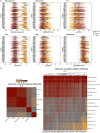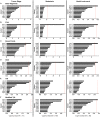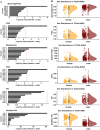This is a preprint.
Inferring chromosomal instability from copy number aberrations as a measure of chromosomal instability across human cancers
- PMID: 37292608
- PMCID: PMC10245901
- DOI: 10.1101/2023.05.24.542174
Inferring chromosomal instability from copy number aberrations as a measure of chromosomal instability across human cancers
Update in
-
Inferring chromosomal instability from copy number aberrations as a measure of chromosomal instability across human cancers.Cancer Rep (Hoboken). 2023 Dec;6(12):e1902. doi: 10.1002/cnr2.1902. Epub 2023 Sep 8. Cancer Rep (Hoboken). 2023. PMID: 37680168 Free PMC article.
Abstract
Background: Cancer is a complex disease that is the second leading cause of death in the United States. Despite research efforts, the ability to manage cancer and select optimal therapeutic responses for each patient remains elusive. Chromosomal instability (CIN) is primarily a product of segregation errors wherein one or many chromosomes, in part or whole, vary in number. CIN is an enabling characteristic of cancer, contributes to tumor-cell heterogeneity, and plays a crucial role in the multistep tumorigenesis process, especially in tumor growth and initiation and in response to treatment.
Aims: Multiple studies have reported different metrics for analyzing copy number aberrations as surrogates of CIN from DNA copy number variation data. However, these metrics differ in how they are calculated with respect to the type of variation, the magnitude of change, and the inclusion of breakpoints. Here we compared metrics capturing CIN as either numerical aberrations, structural aberrations, or a combination of the two across 33 cancer data sets from The Cancer Genome Atlas (TCGA).
Methods and results: Using CIN inferred by methods in the CINmetrics R package, we evaluated how six copy number CIN surrogates compared across TCGA cohorts by assessing each across tumor types, as well as how they associate with tumor stage, metastasis, and nodal involvement, and with respect to patient sex.
Conclusions: We found that the tumor type impacts how well any two given CIN metrics correlate. While we also identified overlap between metrics regarding their association with clinical characteristics and patient sex, there was not complete agreement between metrics. We identified several cases where only one CIN metric was significantly associated with a clinical characteristic or patient sex for a given tumor type. Therefore, caution should be used when describing CIN based on a given metric or comparing it to other studies.
Conflict of interest statement
Conflicts of Interest
The authors have no conflicts to declare.
Figures



Similar articles
-
Inferring chromosomal instability from copy number aberrations as a measure of chromosomal instability across human cancers.Cancer Rep (Hoboken). 2023 Dec;6(12):e1902. doi: 10.1002/cnr2.1902. Epub 2023 Sep 8. Cancer Rep (Hoboken). 2023. PMID: 37680168 Free PMC article.
-
CINmetrics: an R package for analyzing copy number aberrations as a measure of chromosomal instability.PeerJ. 2023 Apr 25;11:e15244. doi: 10.7717/peerj.15244. eCollection 2023. PeerJ. 2023. PMID: 37123011 Free PMC article.
-
Quantifying chromosomal instability from intratumoral karyotype diversity using agent-based modeling and Bayesian inference.Elife. 2022 Apr 5;11:e69799. doi: 10.7554/eLife.69799. Elife. 2022. PMID: 35380536 Free PMC article.
-
Centrosome Aberrations as Drivers of Chromosomal Instability in Breast Cancer.Endocrinology. 2021 Dec 1;162(12):bqab208. doi: 10.1210/endocr/bqab208. Endocrinology. 2021. PMID: 34606589 Free PMC article. Review.
-
Chromosomal Instability in Gastric Cancer: Role in Tumor Development, Progression, and Therapy.Int J Mol Sci. 2023 Nov 30;24(23):16961. doi: 10.3390/ijms242316961. Int J Mol Sci. 2023. PMID: 38069284 Free PMC article. Review.
References
Publication types
Grants and funding
LinkOut - more resources
Full Text Sources
